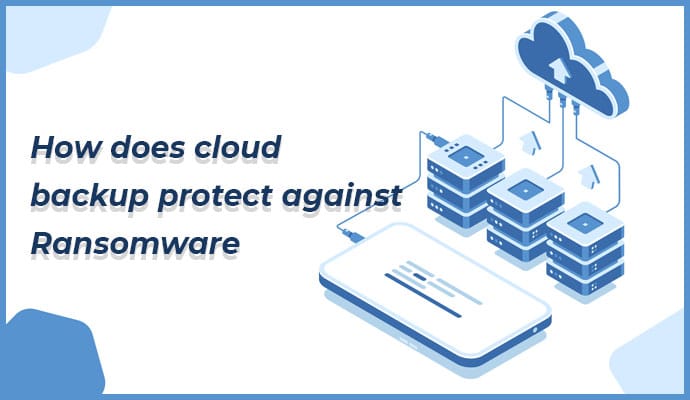With more and more businesses moving to the work-from-home model, there has been an increasing dependency on computer systems and networks. This growing dependency makes the systems vulnerable to malware and with the recent rise in ransomware attacks, a personal computer is not safe either.
Today, Ransomware is one of the biggest cyber-crime threats. A research study by Sophos shows that in 2019, 50% of organizations were attacked by ransomware and in around 75% of the cases, the attackers encrypted the data.
Post the attack, most organizations were able to retrieve their data. Maximum of the organization were able to retrieve their data from their cloud backup and not by paying the demanded ransom. The cost of recovering from the cloud was less than half as compared to the ransom paid up by other organizations.
In the past few years, ransomware attacks are becoming more focused and more dangerous. Though cyber security organizations are facing fewer attacks however there is a major shift with businesses being aimed and targeted.
Whoever may be the target, ransomware can be divided into 3 parts: the initial attack that involves the delivery of the malware, encryption of the victim’s data and communications back to the attacker.
Organizations are attacked in different ways by Malware and social engineering plays a key role in it. More than 30% of ransomware attacks arise when users download malicious files or emails with malicious links.
An increasing volume of ransomware also comes through unprotected remote desktop protocol (RDP) services or unpatched remote access devices.
Using security tools for mail filtering, malware scanning, firewalls and network monitoring can help detect any malicious file or link. Patching and limiting the network users’ access privileges can also be useful.
However, if the systems get attacked and the data is encrypted by the attacker, the best way for an organization to avoid ransomware demands is by having a secure and well-tested cloud backup of the data.
How taking backup is useful in protecting against Ransomware?
Below mentioned are five steps showing how to use a backup to protect against ransomware:
1] Backup Policies
The best way to protect one’s business against malware is to be able to restore data from clean backups. In a ransomware attack even if an organization pays a ransom, it is not guaranteed that the attackers will pass on the decryption key.
Restoring your data from backups is comparatively more dependable, cheaper, and helps from not handing money to criminals.
The best way to take backup is by following the 3-2-1 rule. Make 3 copies of data, store it in 2 different forms of media and keep 1 copy off-site on the cloud.
To protect against ransomware, the cloud backup should be insulated from the business network.
2] Air gap business data
Cloud storage is very useful for storing long-term data backups. In some areas, cloud storage has also replaced physical backup devices like external hard drives, optical disks, portable hard drives and tape.
Cloud storage safeguards the data from any form of physical interruption like hardware or power failures, or storm and flooding.
Keep an offsite copy on the Cloud and another copy on tape. Keep the tapes strictly offline and inaccessible, this is the most reliable way to “air gap” data from a ransomware attack.
3] Make regular backups
Data should be backed up regularly. The CIO should regularly review the policies related to backups to determine how often the data should be backed up, where the data should be backed up etc.
IT teams should also review how long the backup needs to be kept, as many times ransomware often uses time delays to avoid detection and then targets clean systems. Keeping separate backups for critical business systems will help easier and faster recovery.
4] Ensure clean backups
It is very important to ensuring the backups taken are free of malware and not infected.
Maintaining strict air-gap policies like keeping backup media offline, updating malware detection tools, system patching etc. helps ensure clean backups.
5] Testing and planning
All backup plans need to be planned and tested. It is important to calculate the recovery times and determining whether the data can be recovered completely. All phases of the recovery plan should be tested ideally using duplicate media.
How does cloud backup protect against ransomware?
Most of the times Ransomware goes undetected while using an anti-virus scanning software as it uses signature-based detection. A business needs to have a detailed ransomware defence strategy more than having a regular up-to-date antivirus and taking regular backups of your data.
Many times Ransomware can go undetected for days before the actual problem is found. Data-aware cloud storage and backup solution has distinct advantages and can protect against ransomware attacks.
It can detect any kind of abnormal file access or file modification activity, identify the user account and block further abnormal activity while alerting the administrator. Moreover, it can also isolate the infected files and enable effective quarantine and recovery processes.
Integral Choice is a Telecommunication and Cloud Agency offering Customer Migration to hosted data center and contact centre IP services. We help integrate cloud solutions into your business practices ensuring usability and accessibility to your employees.
We offer an array of cloud solutions suitable for all types of businesses and their needs. The key benefit of having a cloud-based solution is the level of flexibility and security it offers.
We understand the increasing communication needs of the modern-day workplace and therefore offer varied cloud solutions options that are readily available to keep a business going.

